I fought in Vietnam
Viet Cong called the seals "soldiers with green faces."
The material proposed below is based on the memoirs of US Navy Special Forces veterans of the captains 2 rank Mike Walsh and Grant Telfer.
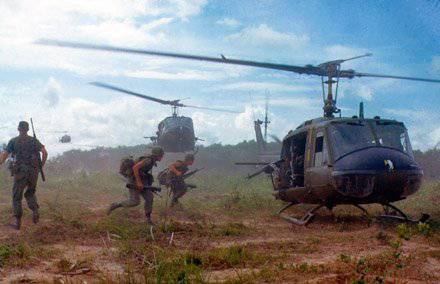
MIKE WALSH: "ALL WE EVER DEFENDS FROM THE SEA"
I entered the fleet in September 1966 after graduating from high school. I hesitated between joining an army special forces or fleet special forces. After much deliberation, I chose the sea, since it is more difficult to act in the water.
In order to become a “cat”, the candidate must pass the main course of the diver-demolition man, which lasts almost six months. Overcoming this test is awarded the badge, which is conventionally called the "trident" (trident). It depicts an eagle clutching an anchor, a pistol and a trident in its paws.
I completed the 18 weekly UDT (underwater demolition training) training program.
This required incredible effort from us. The course included a lot of physical training, many of which took place on the coastal sand.
They studied everything here - from tying sea knots to controlling an inflatable boat, which is not at all easy. After all, working with all the oars, you need to cope with the surf and disembark. Such training hardens and teaches a lot. And above all, understand how to act at sea.
This is a good school, which very quickly makes it clear who is worth. During the course, I weighed 54 a kilogram with 170 growth. Then the instructors looked at me with bewilderment: “What will these formic urine sprays do?” They sometimes stared at me during classes, but I responded with a furious look to them. This is the only protection I could then apply.
And then came the “hell week” when you really start to feel sorry for yourself and think about whether you made the right choice when you decided to become a “sea lion”. Of course, you can quit everything at any time, but personally I wanted to overcome this most difficult stage, because I was internally convinced that I would make a big mistake in my temper, which I would later regret all my life. This week has become truly life-changing for many. During this test, you sleep no more than two hours a day, because the program itself is aimed at identifying the safety factor of people, the hidden reserves of their endurance.
Hell week
The test usually began on Sunday at night. And on Tuesday, a test was made on an obstacle course, where real explosive charges are undermined - these are two hundred gram TNT checkers, which imitate artillery or mortar fire. By this time, the cadets are already quite tired, and from the explosions begins to ring in the ears. And by the evening of Tuesday, many begin to hallucinate, some simply are not able to distinguish reality from delusion. Everyone is so tired that sometimes they can even fall out of the boat into the sea. It may seem strange, but people are tired from sleep even in water. I saw some people fall asleep while swimming long distances. To avoid trouble, you need to keep a close eye on your partner during the voyage. This is a habit. As soon as you see that your partner, who has to swim straight, suddenly turns aside, you should have time to grab him and return him to the given course. This is how one of the main rules of the “seals” is formed - never to leave your companion.
The training course and the "hell week" reveal whether the candidate has the same inner core. In the future, beginners develop their abilities. I happened to meet during the preparation with Lieutenant Pecachek. He was wounded in Vietnam when a platoon was ambushed. His skull was torn down. His comrades collected their brains from the deck and put them back in the skull box, taping it with adhesive tape. They were sure he was dead. But he survived ...
I took a training course with my friends when, during our “hell week,” he was taken in a wheelchair to the pool, where he was undergoing swimming therapy. Special rubber circles for legs, neck and hands were put on him. He looked like a gorilla in this outfit, but swam. A furious fire burned in his eyes. When he was swimming past me, it seemed to me that he paused to go the distance, but instead he stared at me and barked at the top of his lungs: “Ho-ya-a!” - and swam further. He acted like a real warrior. Pečáček was a very strong man, and nothing could break his spirit. I remember this meeting forever.
Upon completion of training, the cadets were sent to the UDT (underwater demolition team) - to the teams of divers-bombers or to the teams of the newly created SEAL. This was followed by a six-month desert preparation course. It worked out a complicated program of infantry actions, tactics of small groups, and also studied weapon. There was a lot of it, so much that I don’t remember that after that I once had a chance to see more.
Circle of favorites
And then I was sent to Vietnam, where by that time the war had been going on for the third year.
Some say that in Vietnam there were 14 platoons, but I think that there were no more than six - about 350 people. True, General William Westmoreland, who had a very high opinion of the "seals", wanted to bring our numbers to 500. If this had happened, perhaps the war would have gone differently. And nowadays even these very 350 people have never fully acted in the war in the interests of the command. The reason is that a lot of "seals" participated in the program "Phoenix", which was developed and implemented by the CIA. Beginning in 1963, it began to attract SEAL to conduct covert operations. The essence of the operations was to identify the movements and location of the Viet Cong units, to detect and capture officers of the army of North Vietnam by setting ambushes or conducting raids. It should be noted that due to the poor quality of intelligence information about the enemy, which was provided by the CIA, these operations did not have widespread success. Seals were much more successful when they relied on their own information, which was much more reliable and more timely. The “seals”, like the “green berets,” acted quite successfully, relying on their own network of informants from among local residents.
Nobody did this job better than us. All SEAL platoons and South Vietnamese police intelligence units were engaged in intelligence gathering. The acquired and analyzed information of the divisions of the "seals" was implemented jointly with the fleet intelligence liaison officers responsible for the relevant area.
This program really worked. The very Viet Cong already at the end of the war, when they largely controlled the situation in South Vietnam, said: “The only thing that really hurts us is the Phoenix program.”
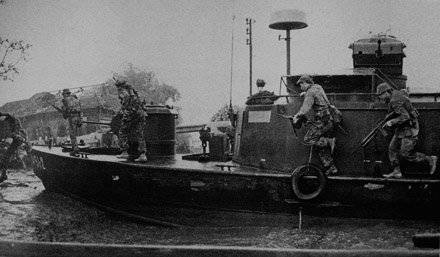
Then I was just 22 of the year, but I was an adviser to whom the CIA subordinated a group of mercenaries from 105 people. Many people call the Phoenix program a murder program, but the CIA called it the Counter Terror Program, which is more true. After all, we were not aimed precisely at the destruction of the identified leaders of the Viet Cong. First of all, we were interested in receiving information from them, but they did not surrender. And the dead, as you know, are reticent.
About the enemy
The enemy had a lot of women. And I must say that it was much more difficult to break them than men. Their spirit was stronger. This feature of women leaders of the Viet Cong took advantage of. And we knew that it was precisely the terrorists who should be more afraid.
Vietcong had a very efficient and extensive infrastructure, which, in fact, repeated the structure of their society. The smallest cell is the family. A group of families is a village, a group of villages is a district, a group of districts is a region. Having built a management system in this way, the Vietcong quickly and effectively took control of the country when the government of South Vietnam fell. Therefore, the most important sites of the Phoenix program were the major leaders of this infrastructure. This is not to say that their destruction was a simple task. One of the officers of the "seals", who is no longer alive, managed to kill the officer of the central headquarters of South Vietnam. This headquarters led the entire underground infrastructure and was quite numerous. He was defended with all his might and even evacuated to Cambodia when there was a threat from our side.
We also managed to destroy three officers of the regional level, two of them corresponded to a two-star general. In addition, they managed to capture their documentation, which was immediately shipped abroad.
The Vietnamese Communists kept the strictest records, and they had documentation, although handwritten, but very detailed and accurate. Most of all I liked their cards. At the end of the war, I even stopped taking them as a trophy, they were so accurate and detailed that we used them. Absolutely all channels and paths were applied on them, which we had no idea at all. Using their maps, we found out where their secret paths and connecting routes pass.
In the framework of the program "Phoenix"
During my first business trip, I had a skirmish with the general of the North Vietnamese army. Of course, I did not yet know that he was a general, since his activity had been revealed later. He was preparing a major offensive in 1969 and carried a notebook with him, in which his position and tasks were recorded, as well as security evidence for traveling from North Vietnam to the Mekong Delta.
Then we literally bumped into his command post, and I in the dark grappled with him hand to hand. He moved me in such a way that sparks spilled from my eyes. It was a blow that they considered fatal. He was a big man with a boxer body, very strong and very well trained. So sharp that I didn’t even notice the blow, when he drove me to the cheekbone. Strange, instead of finishing me, he rushed to run. We were dressed as Vietcong, in black pajamas and a conical hat. Because of my height, he took me for one of his bodyguards. I had AK-47, I fired a few bursts into it and hit six bullets.
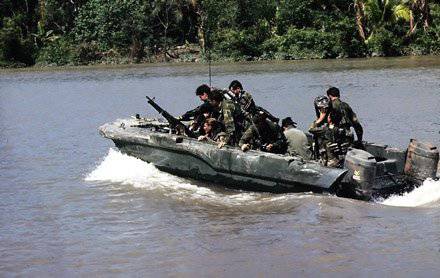
28 February 1971, I acted with a platoon of X-ray. We took with us to the exit of the defector, whom I did not trust. We moved to the area on our boat. The defector was sitting on the nose as a guide. We carried thirty kilograms on ourselves, but our cargo got wet because of the rain and stuck dirt and weighed all the 45. The boat was trying to pick up speed, but at this very time we were ambushed. They planted the first B-40 grenade into our side, and the second one was shot at the crown of a tree, and fragments of the explosion fell upon us. The explosion was so powerful that a few severed limbs. The Vietnamese translator tore both legs. One of our guys also lost a leg. The bulk of the fragments fell into a defector, and this saved me. Splinters hooked only partially. Ed Jones managed to deploy his 50 machine gun caliber and opened fire on the enemy.
I saw a wounded defector, who was lying and smiling, knowing that he had managed to ambush us. I could not stand it and finished him off with my knife.
After this incident, I decided to become an officer. I was a foreman of 2 class and entered the University of Southern Illinois, and after 8 years I was awarded the first officer's rank.
PLACE OFFICER TELFER
Grant Telfer became an officer after graduating from the Naval Academy. He was born in July 1941 in Seattle, grew up in the area and entered the Naval Academy. He skied a lot, played defender in the football team and was a good swimmer. Unlike many fighters of SEAL, he was not interested in shooting or hunting, because, studying at the academy, he ruined his eyesight - he read a lot at night with a flashlight. Since then, in the dark, he did not see anything at all and could not shoot without glasses. Nevertheless, he was sent to Vietnam, having completed a basic training course on “seals”.
Next we give a story about the last operation of his platoon, which is based on his memories.
In the middle of the day
In the second half of 1970, the South Vietnamese government decided to relocate the residents who lived on the Kamau Peninsula. This area was terrorized by the Viet Cong. Telfer's platoon provided security when relocating Vietnamese citizens to a new residential complex near Nam Kan. The Vietnamese government moved people and their belongings during the day. The Kittens, together with the army of the Republic of Vietnam and local self-defense forces, prevented Viet Cong rebels from interfering in the resettlement process.
Trained to combat swimmers trained and trained to perform covert operations, it seemed that when they landed from helicopters during the day, they unmasked their actions. Telfer shared this concern. Moreover, the soldiers of his platoon had already packed most of their belongings for returning to the United States and, as they say, "lay down on the ground", avoiding participation in serious operations. A maximum of a week, they hoped to be home.
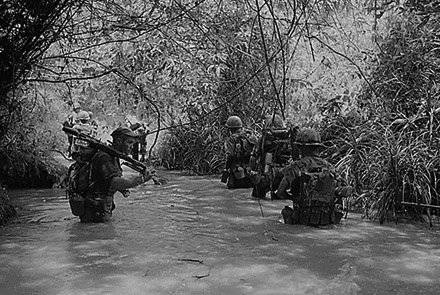
However, on January 28, having met small groups of insurgents during the day patrolling, combat swimmers developed daily cleansing activities for the area. The Vietnamese administration asked the Americans to allocate more patrol teams to provide security during the daytime, and Telfer, despite preparing for a replacement, began to plan his platoon.
Preparing to exit
That same evening, Telfer gave preliminary orders to his platoon. For the operation, he selected five fighters and listed the weapons and equipment that they had to take with them. The morale of the "seals" was high, because for all the 58 operations in which they had been involved before, there was no loss in the platoon. By the way, in the period from 1965 to 1972, the SEAL unit in Vietnam lost all 46 people killed.
Around noon, Telfer gave a combat order to his team, consisting of five combat swimmers. He also invited pilots of combat helicopters to the task, as a result of which they received clear and comprehensive tasks and information about the nature of the upcoming operation.
Unsuccessful departure
At 13.30, a six-man unit headed by Telfer flew aboard the helicopter from the base at Nam Kan. To perform the task, the commander could attract other platoon soldiers, but in this case the size of the squad was limited to the helicopter's payload. The sky was clear, and the helicopter headed north-east to the landing site, which was about 20 kilometers from the base.
Approximately one mile from the landing site, the radio operator Arroyo suddenly received a bullet wound.
The Donald Futrell machine gunner had a large first-aid kit with him, and he and Harry Lawrence began to help the wounded man. As it turned out, the radio operator received two bullet wounds from the 7,62-mm AK-47 assault rifle in his left shoulder. The two of them dragged a vest and shirt from Arroyo and put a bandage on the wounds. After the first shock had passed and the pain began to intensify, they injected the wounded morphine.
At the same time, Telfer ordered the pilot to deploy a helicopter and take a course back. The ambulance was already waiting for them to arrive at the Nam Kan site.
Anger is a bad adviser
The fighters were shocked by the incident, because it was the first loss in six months of a business trip. In their opinion, the radio operator’s injury occurred in some supernatural way. The commando officers, together with the crew of the helicopter, carefully examined the entire helicopter and could not find a single hole. Nevertheless, Arroyo had two bullet wounds at a distance of several centimeters from each other. Probably, the bullets hit the open door.
The commander and subordinates sharpened offense and disappointment, because before that they had fought without loss. In addition, they were well aware that if they did not use the current moment to avenge their comrade, they would never avenge him, because January 30 was their last exit before replacing. Therefore, revenge was to take place today. It was these emotions, and not common sense, that led the commander and soldiers of the Zulu platoon when they re-took off on helicopters and headed for the area where their comrade was wounded.
Preparing for re-departure
Together with the crew of the helicopter, they figured out that the fire was most likely from a dam that was covered with grass and trees.
Telfer ordered a flight from a Seawolf fire support helicopter commanded by Lieutenant Nelson to be prepared for departure. They received the task Telfer process fire dam throughout its length from south to north. The Zulu platoon fighters were supposed to land west, not far from another dam that ran parallel to the target.
The loss of Arroyo, who was the radio operator of the team, created problems in managing the team and its communication with the center. In addition, it somewhat reduced the fire power of the Telfer team, as Arroyo was armed with a shortened version of the M-16 A1 rifle, on which an 40-mm sub-barrel grenade launcher was also attached. In order to compensate for this loss, Telfer asked his deputy lieutenant Thomas Richards (later Richards rose to the rank of rear admiral and led the special operations forces of the US Navy. He was responsible for all operations that were carried out by “seals” in different parts of the world) to replace the wounded radio operator . The lieutenant, as well as Arroyo, worked on the radio model PRC-77, in addition, he was armed with a light machine gun "Stoner 63". The lieutenant did not have to beg, because he met the helicopter with the wounded man on board and saw everything himself. Rifle radio operator took the commander.
Disembarkation
Having taken off for the second time, the SEAL branch already in 15 minutes had the goal, having entered it from the south-west. In 14.30, a helicopter landed a branch, led by Telfer, on a dry rice field at 250 meters from the dam of interest. At this time, a pair of Seawolf helicopters was covering them in the air, ready, at Telfer’s request, from the ground to bring down their fire on the enemy. The landing took place calmly, and Telfer decided to head north-east with his men. They moved about 50 meters from the helicopter and came under fire from small arms. The fire was fired from the dam, which was scheduled as a landing target and was located about 150 meters from the Americans. The enemy beat aimingly, and his fire was quite intense, which created a threat to the lives of American soldiers. Since they were shooting from Kalashnikovs, it was possible to assume that the “seals” collided with the main forces of the Viet Cong or with a well-armed local rebel unit. At the same time, Telfer did not hear the machine guns, which, in turn, was a good sign.
On the radio station, Telfer summoned the helicopters and asked them to deliver a powerful blow to the dam, where the enemy sat down. Having received the command, the helicopter pilots frolicked in plenty, passing by turns over the dam and laying out a stock of missiles on its surface. In addition, they processed a dam of rapid-fire machine guns. The assault was so powerful that one of the “seals” was wounded in the face. He was caught by a shard from rockets fired from helicopters or by a piece of palm tree that flew off during the explosion. The roar of shots and explosions, smoke and dust, twisted trees, apparently made a strong impression on the Viet Cong, and they ceased firing.
We get them, Mr. Telfer
From the side of the helicopter, Nelson reported to Telfer that on the dam, in the open, lay two motionless bodies of Viet Cong, apparently killed. He also said that he sees their weapons next to the bodies and observes at least one partisan fleeing to the north outside the region. This report has become a critical point in the course of action. Telfer should have made a fundamental decision in the current situation. On the one hand, his team was discovered and fired upon by the enemy, therefore, continuing further actions in the area, Telfer endangered his unit. At the same time, information about the two killed Viet Cong provoked him to further action. He wanted to personally make sure that two enemy fighters were destroyed. Information about the dead and retreating Viet Cong created the illusion of victory.
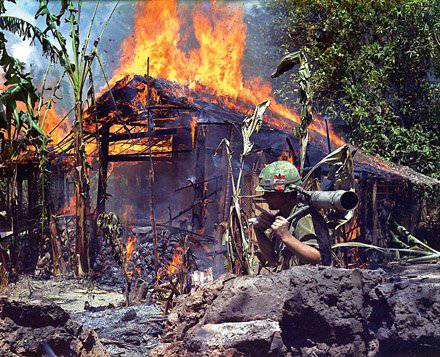
Therefore, Telfer ordered the commander of the fire support helicopter to work on the enemy, who seemed to have moved north. Then he ordered his patrol to move north along a dam overgrown with grass. Meters in 50 to the east, he, as he hoped, found the enemy's abandoned positions. The mood of the fighters was militant, and this satisfied him. Nobody was screaming and not afraid to go on. On the contrary, James Rowland said: "Let's go and get them, Mr. Telfer."
The patrol went north along the dam a few more meters, and then turned right to another dam that went east directly to the Viet Cong positions, which were obviously empty. Rowland reached the connecting dam and slowly began to cross it. Everything was quiet until Oliver Hedge, who was walking in the rear guard, came to this dam.
Ambush
At this time, Rowland was about 20 meters from the dam where the enemy was stationed. Telfer was about 6 meters behind him and heard nothing — he only saw that Rowland had suddenly fallen into dry rice. The bullet that cut Rowland went from left to right through his stomach and came out on the right on his back, breaking through the high-power plastic explosive unit C-4, which he carried in his backpack. When he fell, another bullet hit him in the back. Despite the severe wound Rowland was alive.
The rest of the combat swimmers were under heavy fire of the Viet Cong fighters, who were also armed with SKS carbines and AK-47 assault rifles. The positions of the enemy were prepared in the dam, which on the front in front of the patrol hid grass and foliage. And here Telfer made another mistake. Instead of falling to the ground and opening fire on the enemy, he instinctively rushed forward to help Rowland. But after passing no more than one and a half meters, the platoon commander was also injured. The bullet struck on the left, throwing Telfer at the dried rice stalks next to Rowland.
A 7,62 millimeter bullet entered the front of Telfer’s left knee, knocking him down. Instead of just knocking the knee, a heavy bullet almost killed Telfer by changing the direction of motion to 90 degrees, and stitched his left thigh, hitting him in the groin on the left side, where, changing the direction and passing through the groin in his right leg, he was stuck in front of the femoral artery . If the bullet had gone half an inch more, Telfer would have died. Surprisingly, at first he practically did not feel pain. Only after a few seconds, both of his legs began to get numb. Wounded in both legs and lower abdomen, he could transfer command to his deputy Richards and take care of himself.
However, Telfer crawled back up to the dam, along which he had just walked, in order to locate the enemy firing points and respond to him with the fire of combat swimmers. As Telfer returned to the dam, Richards radioed a transport helicopter to evacuate the wounded, which could land behind them approximately 80 meters to the west. The evacuation site was an extensive dry rice field, which was covered by a large dam at the rear.
Went around
The bullets continued to whistle and plop around them. When the bullets began digging up the ground nearby, both officers realized that now the Viet Cong were firing not only to the left of the dam, but also to the right. As a result, the "seals" were left without cover, which put them in a very dangerous position. Lawrence and Futrell got close to Telfer, who ordered them to help Rowland. After that, Lawrence began to beat with a machine gun along the dam in the direction of the northeast, and at this time Futrell provided first aid to Telfer. Seeing where the enemy’s bullets fell, Lawrence began beating east and south-east. At this time, Richards and Hage also fired at the enemy.
Despite the injury, Telfer managed to shoot one 40-mm grenade from an under-barrel grenade launcher, and also to shoot one store. Telfer's watch showed 15.03, and he realized that the entire combat contact lasted for no more than seven minutes. His thoughts were busy rescue operation. Despite the current situation, the severe wound he had received and the likely death of Rowland, he felt that the situation was still under control. But after a few seconds, it changed dramatically for the worse. Futrell, belted with machine-gun belts, turned away from Telfer and opened fire on the enemy with his machine gun, but at that moment the 7,62-mm bullet hit and turned him again towards the commander. The bullet entered the left chest, passed a centimeter from the heart and pierced the left lung, as well as the chest veins and arteries. Telfer, seeing this, despite his numb legs, crawled to the machine gunner. For the first time, he was afraid that his entire unit might die.
Evacuation
A second later, Richards screamed in pain as a bullet pierced his right arm. This was the fourth injury in the ward.
Under the cover of Lawrence and Hedge, wounded combat swimmers managed to crawl safely to the northern part of the dam. Despite the fact that two of them were injured by fire from this direction, it seemed to them that here they could take refuge in a small ditch. Indeed, the enemy’s fire from the south was the strongest and, as it seemed, was fired from a small house located 100 meters to the south.
Rowland, Telfer and Futrell, who were badly injured, could not crawl to a safe place through a large dam at the end of the ditch, and then Richards, despite his wounded arm, dragged each of them into the shelter. A transport helicopter landed a few meters away. With the help of the rest of the patrol soldiers, the combat swimmers, overcoming the pain, reached him. Fingers and forearms were burned by heated guns. As he moved to the helicopter, Telfer’s wounds began to cause him incredible pain. The waiting helicopter received several holes while it took on board all members of the Telfer patrol. The fight was finally over.
"Adov Week", saving lives
Four seriously wounded, including Arroyo, were evacuated to an air force hospital in Japan. Being in a hospital bed, they repeatedly discussed their last, almost fatal for them, way out, identifying the key moments of those events. Analyzing the situation, they constantly asked themselves how they managed to survive in the current conditions. Everyone agreed that it was not necessary to go to the dam under any circumstances. They also concluded that they managed to survive only thanks to the intensive training they underwent. They were trained to respond in cold blood to various changes in the situation, including the situation in which they were 30 January. They paid particular attention to the preparation stage of SEAL, which is called “Adov Week”. It was she who helped all the fighters to remain united and not to panic in the critical situation of that battle.
Continuation of the "village dance"
The events described above were continued on January 30 of the year 1971. The remaining daylight fire support helicopters treated the positions of the Viet Cong in the area of the morning battle. Also Vietnamese and American units went there to search the area. The resistance of the Vietcong was fierce. Virtually all helicopters that had flown into the area for strikes got holes.
A few days later, the agent reported that there was a Viet Cong unit numbering about 65 in the area.
Finale
In 1970, the administration of Richard Nixon set the course for a gradual exit from this war. One of the programs was the Vietnamization of the conflict, the essence of which was to increasingly attract the Vietnamese people to resolve their internal conflict. American units are less involved in the conduct of hostilities. The last killed in the “seal” units in this war was Lieutenant Melvin Dry, who crashed after jumping from a helicopter into the water from a height of about 10 meters, during an operation to free prisoners.
Information